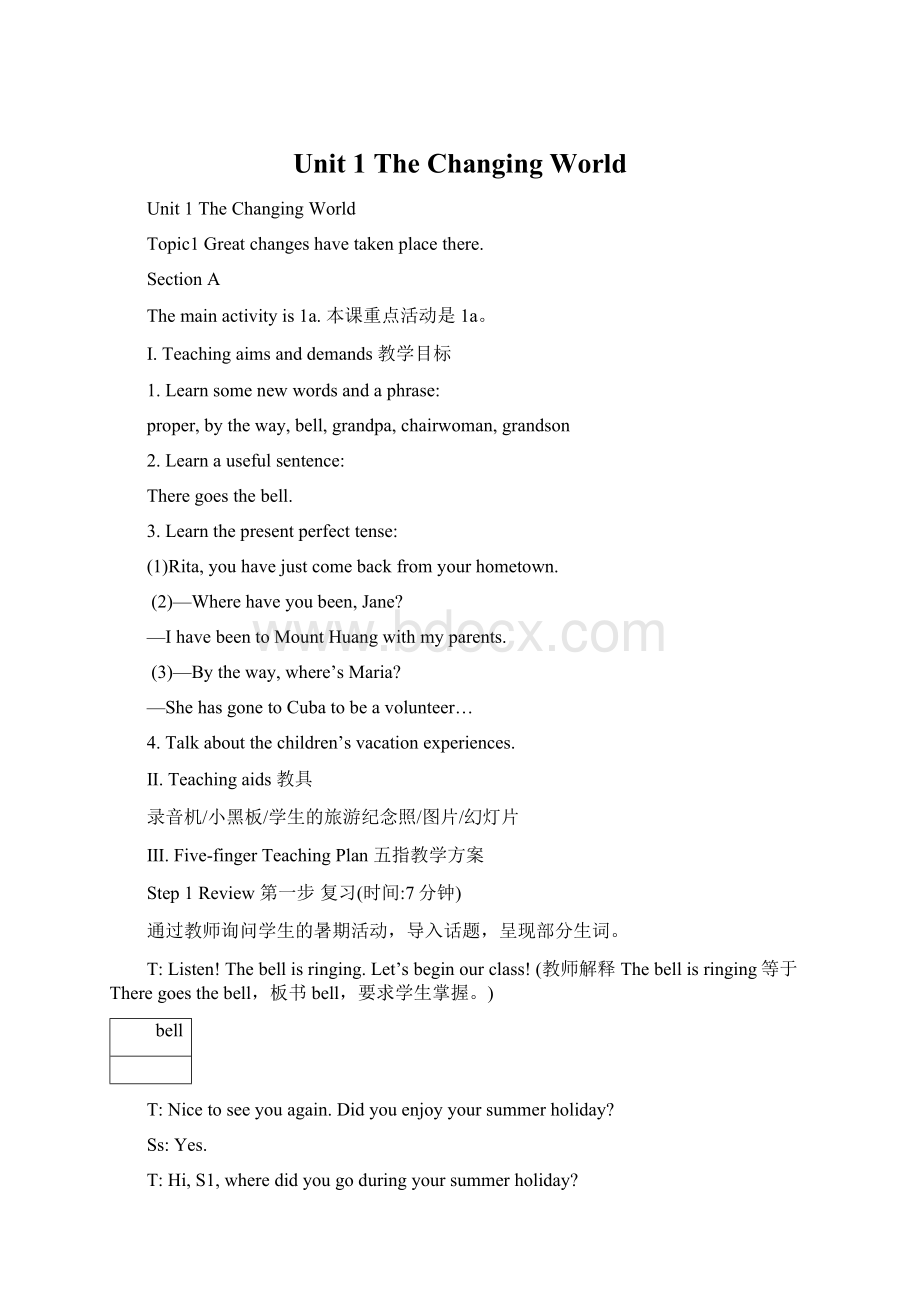 Unit 1 The Changing World.docx
Unit 1 The Changing World.docx
- 文档编号:6283867
- 上传时间:2023-01-05
- 格式:DOCX
- 页数:24
- 大小:89.10KB
Unit 1 The Changing World.docx
《Unit 1 The Changing World.docx》由会员分享,可在线阅读,更多相关《Unit 1 The Changing World.docx(24页珍藏版)》请在冰豆网上搜索。

Unit1TheChangingWorld
Unit1TheChangingWorld
Topic1Greatchangeshavetakenplacethere.
SectionA
Themainactivityis1a.本课重点活动是1a。
Ⅰ.Teachingaimsanddemands教学目标
1.Learnsomenewwordsandaphrase:
proper,bytheway,bell,grandpa,chairwoman,grandson
2.Learnausefulsentence:
Theregoesthebell.
3.Learnthepresentperfecttense:
(1)Rita,youhavejustcomebackfromyourhometown.
(2)—Wherehaveyoubeen,Jane?
—IhavebeentoMountHuangwithmyparents.
(3)—Bytheway,where’sMaria?
—ShehasgonetoCubatobeavolunteer…
4.Talkaboutthechildren’svacationexperiences.
Ⅱ.Teachingaids教具
录音机/小黑板/学生的旅游纪念照/图片/幻灯片
Ⅲ.Five-fingerTeachingPlan五指教学方案
Step1Review第一步复习(时间:
7分钟)
通过教师询问学生的暑期活动,导入话题,呈现部分生词。
T:
Listen!
Thebellisringing.Let’sbeginourclass!
(教师解释Thebellisringing等于Theregoesthebell,板书bell,要求学生掌握。
)
bell
T:
Nicetoseeyouagain.Didyouenjoyyoursummerholiday?
Ss:
Yes.
T:
Hi,S1,wheredidyougoduringyoursummerholiday?
S1:
Iwentto…
T:
S2,didyougotoyourgrandpa’shome?
S2:
Yes.
(板书grandpa,要求学生掌握。
)
grandpa
T:
S3,wheredidyougo?
S3:
IwenttotheWestLakewithmyfather.
T:
Wow!
TheWestLakeisabeautifulplace.Whatdidyoudothere?
S3:
Ienjoyedthebeautifulscenery,tookphotosandboughtmanybeautifulpostcards.
T:
S4,whataboutyou?
S4:
Ihadtostayathometohelpmymotherwiththehousework.
T:
Oh,Ifeelgladforwhatyoudid,andIthinkyou’reagoodgirl.You’rehelpful.S5,didyougotosummerclasses?
S5:
Yes,Idid.IwenttoanEnglishtrainingschooltoimprovemyEnglish.IthinktheEnglishtrainingschoolisaniceplaceformetoimprovemyEnglish.
T:
Yes.TheEnglishtrainingschoolisaproperplacetoimproveyourEnglish.
(板书生词,请学生猜汉语意思并领读,要求学生掌握。
)
proper
T:
OK,youallhadagoodsummerholiday.WhataboutKangkangandhisfriends?
Let’scometothenewunitnow.
Step2Presentation第二步呈现(时间:
15分钟)
创设语言情境,呈现have/hasbeento和have/hasgoneto及部分生词。
1.(创设对话情境。
Mr.Smith星期六组织Class2去野营,大家在校门口集合时发现Jim没来。
师生对话,呈现have/hasgoneto…)
Mr.Smith:
Hello,everyone!
Jimisn’there.Whereishe?
S1:
Maybeheisathome.
S2:
Maybeheisill.
…
Mr.Smith:
No.HehasgonetoBeijingtobeavolunteer.
(板书并让学生了解volunteer,教师适当讲解have/hasgoneto的用法,并让学生初步掌握。
)
have/hasgoneto,volunteer
(假设星期一Jim返回学校,Mr.Smith和Jim展开对话,呈现have/hasbeento。
)
Jim:
Goodmorning,Mr.Smith.
Mr.Smith:
Goodmorning,Jim.YouhavejustcomebackfromBeijing.Howwasyourtrip?
Jim:
Cool!
Mr.Smith:
Ithinkyouhavebeentomanyplacesofinterest.
(板书并适当讲解,要求学生初步掌握。
)
have/hasbeento
(教师可用简笔画呈现have/hasbeento和have/hasgoneto,讲解它们的区别并要求学生掌握。
)
2.(师生对话,简单操练have/hasbeento和have/hasgoneto的用法。
)
(教师特意让S3去办公室取作业。
)
T:
Didyouhaveagoodsummerholiday,S4?
S4:
Yes.
T:
Wherehaveyoubeen?
S4:
Ihavebeento…
T:
Bytheway,whereisS3?
S4:
Hehasgonetotheteacher’soffice.
(板书bytheway,要求学生掌握。
)
bytheway
3.(播放1a录音,回答小黑板上呈现的问题。
以听力的形式呈现1a的主要内容。
)
T:
Now,listento1a.Kangkangandhisfriendsaretalkingabouttheirdifferentexperiencesduringtheholiday.Answerthefollowingquestionsonthesmallblackboard:
(出示小黑板。
)
(1)WhohasjustcomebackfromIndia?
(2)WherehasJanebeen?
(3)WherehasKangkangbeen?
(4)Whoisn’tatschool?
T:
From1a,weknowsomeonehasjustcomebackfromIndia.Whoisshe?
(教师加重语气读hasjustcomeback。
)
S5:
Rita.
T:
Yes.Youhavetherightanswer.RitahasbeentoherhometowninIndiainhersummerholiday.ButnowsheisinChina.WecansayshehasbeentoIndia.WherehasJanebeen?
S6:
MountHuang.
(教师引导学生用现在完成时表达。
)
T:
Yes.ShehasbeentoMountHuang.WherehasKangkangbeen?
S7:
HehasbeentoanEnglishsummerschool.
4.(重放1a录音,总结重点句型并板书。
)
T:
Listentothetapeagain.Thentalkaboutwhattheyhavedone.
RitahasjustcomebackfromIndia.Shehasbeento…
Janehasbeento…Kangkanghasbeento…
Mariaisn’tatschool.Shehasgoneto…
Step3Consolidation第三步巩固(时间:
10分钟)
巩固1a,完成1b,并引导学生区别一般过去时与现在完成时。
1.(让学生分角色读对话,教师巡视并纠正学生发音。
)
T:
Read1ainroles.Payattentiontoyourpronunciation.
2.(学生独立完成1b的表格。
师生共同核对答案,巩固现在完成时have/hasbeen/goneto这一基本句型。
)
T:
Now,pleasefillinthetablein1baccordingto1a.
3.(由1a对话引导学生谈论暑期生活,继续巩固现在完成时。
)
T:
KangkanghasbeentoanEnglishsummerschooltoimprovehisEnglish.RitahasbeentoIndia.Whataboutyou?
Wherehaveyoubeen?
Andwhatdidyoudo?
Pleaseworkingroupsofthreetotalkaboutyoursummerholidays.
(学生三人一组进行问答。
)
T:
Whowilltrytoactitoutinfrontoftheclass?
(挑几组学生进行表演,并对学生进行适时指导和鼓励。
)
Example:
S1:
WheredidyougolastSummerholiday?
S2:
IwenttotheWestLake.
S1:
(指S2问S3)Wherehashebeen?
S3:
HehasbeentotheWestLake.
S1:
Whatdidyoudothere?
S2:
Iwentboatingonthelake.
S1:
(指S2问S3)Whatdidhe/shedothere?
S3:
He/Shewentboatingthere.
(教师引导学生区别一般过去时与现在完成时。
)
Step4Practice第四步练习(时间:
8分钟)
完成1c和2,强化练习现在完成时及部分重要词汇。
1.(教师让学生两人一组,每人拿出提前准备好的旅游照片或图片,操练现在完成时。
注意区别一般过去时、一般将来时和现在完成时,完成1c。
)
S1:
Hi,S2.Wherehaveyoubeen?
S2:
IhavebeentoShanghai.
S1:
Whatdidyoudothere?
S2:
Ienjoyedthebeautifulscenerythere.
…
S3:
Hi,S4.WhereisLucy?
S4:
ShehasgonetoMountTai.
S3:
Whenwillshecomeback?
S4:
Shewillcomebackintwodays.
…
2.(根据呈现的have/hasbeento和have/hasgoneto,完成2。
然后核对答案。
在处理2时,板书并讲解,要求学生掌握chairwoman和grandson。
)
chairwoman
grandson
3.(缤纷小赛场。
出示幻灯片或小黑板。
)
(1)Myteachergaveusthepanswerafterthediscussion.(根据首字母填空)
(2)Myfatheroftentookmetomyhometowntoseemyg,akind-heartedoldman.(根据首字母填空)
(3)These(chairwoman)can’tagreewitheachother.(适当形式填空)
(4)—Where’sLucy,Tom?
—Sheherhometowntoseehergrandparents.(单项选择)
A.returntoB.hasgonetoC.hasbeentoD.havegoneto
Step5Project第五步综合探究活动(时间:
5分钟)
让学生完成暑期调查表格,并写出调查报告,进一步熟练运用现在完成时。
1.(教师制作关于暑假活动的表格,让学生通过对话完成表格。
)
Name
Wherehashe/shebeen?
Whatdidhe/shedo?
…
…
2.Homework:
Writeasurveyreportaboutthestudents’summerholidays,usingthesimplepasttenseandthepresentperfecttense.Thereportincludes:
(1)Wherehavetheybeen?
(2)Whatdidtheydo?
板书设计:
Greatchangeshavetakenplacethere.
SectionA
bytheway—Wherehaveyoubeen,Jane?
Theregoesthebell.—Ihavebeento…
proper—Mariaisn’tatschool.Where’sshe?
chairwoman—Shehasgoneto…
SectionB
Themainactivitiesare1aand2a.本课重点活动是1a和2a。
Ⅰ.Teachingaimsanddemands教学目标
1.Learnsomenewwordsandaphrase:
shut,rope,granny,describe,indetail,education,develop,development
2.Learnsomeusefulsentences:
(1)ThoughIhadnotimetotravel,Istillfeltveryhappy.
(2)Isthatso?
(3)Luckily,withthedevelopmentofChina,manythingshavechanged,andchildrencangetagoodeducationnow.
3.Goonlearningthepresentperfecttense:
HasAnn…?
Yes,shehas./No,shehasn’t.
4.LearnaboutthedifferencesbetweentheChineseteenagers’livesinthepastandthoseatpresent.
Ⅱ.Teachingaids教具
图片/录音机/幻灯片
Ⅲ.Five-fingerTeachingPlan五指教学方案
Step1Review第一步复习(时间:
10分钟)
创设情境对话,复习现在完成时态,并学习部分生词。
1.(通过做游戏,复习现在完成时。
)
T:
Hi,boysandgirls.Let’splaythegame“QuickResponse”.
T:
Wherehaveyoubeen,S1?
S1:
IhavebeentoHongKong,andIboughtmanythings.
…
T:
WhereisS2?
S3:
He/ShehasgonetoMr.Lee’soffice.
T:
Whenwillhe/shecomeback?
S3:
Inanhour.
…
2.(教师出示一张吉姆的旅游照片,介绍他的假期经历,导入并教授生词。
)
T:
DoyouwanttoknowwhereJimhasbeenduringhissummerholiday?
Ss:
Yes.
T:
It’saphotoofhim.Letmedescribeitindetail.
(板书并要求学生掌握。
)
describe,indetail
S4:
HashebeentoBeijing?
T:
Yes,hehas.HehasbeentoBeijingwithhisparents,grannyandlittlesister.
(板书并要求学生掌握。
)
granny
T:
Hislittlesisterwentthereforfurthereducation.Herdreamistostudyabroad.Luckily,withthedevelopmentofourcountry,mostofyouwillhaveachancetostudyabroad.Youarealllucky.Buttherearemanydisabledchildren.Theyareunlucky.Weshouldtryourbesttohelpthem.Lookatthispicture.Let’shaveadiscussion.
(板书并适当讲解生词,要求学生掌握education,development,develop;理解disabled;了解luckily。
)
education
luckily
develop→development
disabled
Step2Presentation第二步呈现(时间:
14分钟)
创设语言情境,让学生掌握现在完成时态的一般疑问句,学习部分生词,呈现1a、2a,完成2b。
1.(教师拿出一张“残疾儿童之家”的图片,导入现在完成时的一般疑问句。
)
T:
Thispictureisadisabledchildren’shome.Haveyoueverbeenthere?
(教师可用汉语解释disabledchildren’shome的意思,帮助学生理解。
)
Ss:
Yes,wehave./No,wehaven’t.(引导学生回答。
)
T:
Mariahasbeentoadisabledchildren’shome.DoyouwanttoknowwhatMariahasdonethere?
Ss:
Certainly.
T:
OK.Let’slistentothetapeandanswerthefollowingquestion.Whatdidshedotohelpthem?
(听1a录音回答上面问题,核对答案。
)
T:
DidMariahaveanytimetotravel?
Ss:
No,shedidn’t.Butshestillfelthappy.
T:
Yes.Thoughshehasnotimetotravel,shehaslearnedalotfromherholidayexperiences.
(教师解释though引导让步状语从句,不与but连用。
板书并要求学生掌握。
)
Thoughshehasnotimetotravel,she…
2.(播放1a录音,学生跟读,注意语音和语调。
)
T:
Pleaselistento1aagainandrepeat.Payattentiontothepronunciationandintonation.
3.(听2a录音,回答幻灯片中出示的问题。
)
T:
Todayweallhaveahappylife,butinthepast,people’sliveswereveryhard,evensomechildrenhadtobechildlaborers.Listentothetape,andanswerthefollowingquestions.
(1)DidKangkang’sgrannyhaveahardlifeinthepast?
(2)WhatdidKangkangtellRitaaboutChineseteenagersinthepast?
(3)Howdidmostchildrenspendtheirchildhoodinthepast?
(板书并讲解生词,要求学生理解。
)
laborer,teenager,childhood
4.(学生打开课本,再听2a,跟读并找出疑难点。
)
T:
Openyourbooksnow.Listento2aagainandrepeat.Markthedifficultieswhenyouare
reading.
5.(引导学生说出疑难点和含有现在完成时态的句子,教师讲解疑难点,板书要点并要求学生理解生词support和rapidly。
)
have/liveahardlife
Isthatso?
can’t/couldn’taffordsth.
Ourcountryhasdevelopedrapidly
- 配套讲稿:
如PPT文件的首页显示word图标,表示该PPT已包含配套word讲稿。双击word图标可打开word文档。
- 特殊限制:
部分文档作品中含有的国旗、国徽等图片,仅作为作品整体效果示例展示,禁止商用。设计者仅对作品中独创性部分享有著作权。
- 关 键 词:
- Unit The Changing World
 冰豆网所有资源均是用户自行上传分享,仅供网友学习交流,未经上传用户书面授权,请勿作他用。
冰豆网所有资源均是用户自行上传分享,仅供网友学习交流,未经上传用户书面授权,请勿作他用。


 对中国城市家庭的教育投资行为的理论和实证研究.docx
对中国城市家庭的教育投资行为的理论和实证研究.docx
